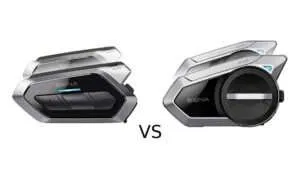Contents
Bluetooth motorcycle helmets are becoming increasingly popular with motorcyclists, especially those who run with a group. Still, some riders question whether these “smart helmets” are valuable enough to be worth the extra money it takes to purchase one.
Are Bluetooth helmets worth it? Bluetooth helmets provide a wide variety of advantages to a motorcycle rider, such as hands-off communication with passengers or other riders, the ability to stream music, and the ability to navigate. Bluetooth helmets are not that much more expensive than regular motorcycle helmets.
Bluetooth helmets are not for every rider, but they’re a great asset to some. Read on to find out more about Bluetooth motorcycle helmets and how they affect your ability to ride.
Bluetooth Helmets Are Worth It, But How Do They Work?
The advantages of using a Bluetooth enabled helmet are numerous (and you’ll see why further down in the article), but how does Bluetooth technology work exactly? Bluetooth is a short-range, wireless communication technology that allows for the passage of both communications and files over short distances through a radio frequency signal. (Source: Digital Trends)
Bluetooth technology is one of the cornerstones of the Internet of Things and the smart device revolution—very few smart devices in the modern age operate without Bluetooth capability. Since the capability of Bluetooth technology is only expanding and it is backward compatible by design, there has never been a better time to invest in a Bluetooth helmet if the upgrade is in your price range.
Bluetooth Helmets vs. Intercom Mounting Systems

The significant difference between a Bluetooth motorcycle helmet and a helmet with an intercom mounting system is that (while these two devices accomplish the same essential task—to communicate with a passenger or another rider) the intercom mounting system is a standalone unit that can be attached to any motorcycle helmet, while the Bluetooth helmet is an integrated system.
Many intercom mounting systems also use wireless Bluetooth technology, but since they can be moved around from helmet to helmet, they are somewhat more adaptable than a Bluetooth helmet. With a standalone Bluetooth intercom system, you can theoretically turn any helmet into a Bluetooth helmet. This lends intercom mounting systems a versatility that Bluetooth helmets don’t have.
However, an advantage that Bluetooth helmets pose over intercom mounting systems is their ease of use. Because the Bluetooth is integrated into the helmet system, the control mechanics tend to be less complicated than with Bluetooth intercom mounting systems (which depend on only a few buttons to control many different functions).
There are also wired intercom mounting systems for use between a rider and passenger, but these are useless for communicating between motorcycle riders on different bikes, and the nature of their design leaves them vulnerable to wear and tear during extended use. On this front, Bluetooth technology is the clear winner, both in Bluetooth helmets and in wireless intercom mounting systems.
Bluetooth Helmets and Communication
There are several advantages of purchasing a Bluetooth helmet if you need to communicate with other riders or passengers while you’re riding.
Here are some of the advantages of communicating through a Bluetooth helmet system:
- Passengers can be instructed to shift their weight or grip or to lean for a more relaxed (or safer) ride.
- Passengers who have never ridden on a motorcycle before are more relaxed and confident when they can speak directly to the rider.
- Riders in the same riding group can communicate with each other to determine navigation points, pull-offs, and other riding issues.
There are a few technical issues when it comes to Bluetooth communications, however. Here are a few of the problems people tend to run into while using Bluetooth for communication on motorcycles:
- Signals: On very twisted or curving roads, wireless connectivity between different bikes can be spotty, leaving riders dependent on hand signals or other secondary communications.
- Volume: The same noise filtering technology used in Bluetooth technology to filter out wind noise and other noise pollution can also dampen the volume of human voices, making communications more difficult at higher speeds with Bluetooth intercom mounting systems. This problem is diminished at a closer range, though.
When it comes to being able to communicate with other riders, no other technology has surpassed Bluetooth helmets. For riders who find themselves needing to communicate with another rider or a passenger frequently, Bluetooth helmets are the way to go.
Bluetooth Helmets and Music
Another benefit that Bluetooth helmets offer a motorcycle rider is the ability to stream music over an Internet connection. For those riders who go on extended trips (and even the ones who don’t), having access to a stream of your favorite tunes piped directly into your helmet is a blessing. And this luxury is achieved without needing to include extra accessories to your helmets, such as earbuds or helmet speakers. (Source: Jam Addict)
Music is considered an advantage for motorcycle riders since it can offer a point of focus that increases alertness and decreases road hypnosis and drowsiness during long rides. A Bluetooth helmet allows riders to listen to music without the added distraction of fiddling with a radio station since it is a hands-off device.
Unlike a motorcycle stereo system that blasts music at everyone around you, drawing unwanted attention, a Bluetooth helmet keeps your music confined to the helmet so that not only can you keep your tunes to yourself, but you can also sync your playlist to your passenger’s helmet as well.
The major disadvantage of listening to music through a Bluetooth helmet is that the added noise can act as a distraction. If music is turned up too loud in a Bluetooth helmet, it can potentially prevent the rider from hearing environmental noise that would alert them of danger, such as an oncoming emergency siren.

Bluetooth helmets are a good option for riders who need navigation for long-distance trips or travel in unfamiliar places since they offer a means of GPS navigation as well as communications. Long gone are the days of having to pull over on the side of a busy highway to pore over a paper map. Now, you don’t even have to slow down or take off your helmet.
Bluetooth navigation apps for your helmet not only tell you the best way to go to avoid traffic, weather, or other delays, but they can also be used to report your location in case of a crime or traffic accident. This is especially important if you are riding in rural areas with steep drop-offs on the side of the road, as a motorcycle over an embankment may not be seen from the road after a crash.
Some state-of-the-art prototypes for Bluetooth enabled GPS helmets even offer augmented reality HUDS as part of the helmet interface. (Source: LiveMap) It’s safe to say that when it comes to motorcycle navigation, Bluetooth helmets are the industry standard.
Bluetooth Helmets and Safety
Bluetooth helmets are considered to contribute to motorcycle safety to a degree since their hands-off capability means that a rider doesn’t have to fiddle with a bunch of controls or mechanisms and can control the helmet via audio commands for complete hands-off capability.
However, there is another school of thought that considers any distractions on the road—even wireless hands-off ones—to be a potential risk and a danger to both passengers, other riders, and other vehicles on the road. This is especially true for motorcycle riders, who have to pay even more attention than the average driver.
Motorcyclists are increasingly the victims of fatal accidents due to a driver’s distraction, which means defensive riding isn’t just a good idea—it could potentially save a rider’s life. If you’re playing with Google Maps, going through your playlists, or chatting with a passenger, you aren’t as focused on defensive riding as you could be.
While scientific studies have reinforced the idea that drivers and riders who use hands-off devices are less likely to get into a crash than those who use manual ones, this doesn’t mean that those riders who focus entirely on the road aren’t less likely to get into a crash than those who are using hands-off technology. (Source: Science Daily)
Bluetooth Helmets and Price

Bluetooth motorcycle helmets run between $150-$350, which means that on the cheaper end of the spectrum, a Bluetooth enabled helmet doesn’t cost that much more than a traditional helmet without Bluetooth capability. However, an important thing to consider with Bluetooth technology is that typically, you get what you pay for—a cheaper Bluetooth helmet is probably not going to have the same range or clarity as a more expensive one.
Because Bluetooth helmets on the cheaper end of the price range aren’t that much more expensive than traditional helmets, this makes a pair of them a good investment for a rider and their passenger. Because the two helmets are so close together, any connectivity issues that you might run into with a cheaper helmet are somewhat mitigated by proximity.
However, more expensive Bluetooth helmets may fall out of the budgets of some riders. If the communications and navigation aspects of the helmet are not used as much as the music is, this can make the cost of the helmet more than the value to the rider. It all depends on the rider and how often they use their helmet’s auxiliary functions.
Limitations of Bluetooth Helmets
Even though there are many advantages of using a Bluetooth helmet on your motorcycle, Bluetooth technology also comes with a set of disadvantages that should be considered before investing in a Bluetooth helmet.
Here are some of the drawbacks of the technology:
- Distraction: Bluetooth technology is considered less distracting than analog technology but is still considered more distracting than not using auxiliary technology behind the handlebars of the bike at all.
- Price: Lower quality Bluetooth helmets can be purchased for roughly the same price as a standard motorcycle helmet, but these Bluetooth helmets will not perform at the same level as Bluetooth helmets at a higher price point.
- Connectivity: Bluetooth devices can have connectivity issues at range, especially when there is a loss of sight between the two relays. The more expensive a Bluetooth helmet is, the more extensive range it typically has.
- Noise reduction: Cheaper Bluetooth devices may overcompensate in noise filtration to drown out road-noise, leading to a Bluetooth connection that is faint or echoey. More expensive Bluetooth helmets have integrated technology to maintain the clarity of music or verbal instructions through the helmet’s audio system while also filtering out road noise.
- Hacking: One problem with Bluetooth connections is that they are often synced to an insecure wireless network, leaving these devices at risk for hacking. Bluetooth is used to hack into smart devices such as cell phones to steal personal data, apply malware, and more. (Source: Cyware)
- Battery life: While Bluetooth technology is beneficial for playing music, making calls, or navigating via GPS, these technologies also drain the battery life of smart devices quickly.
A Bluetooth helmet that is continuously used for its Bluetooth capabilities will need to be recharged often.
For those looking for the cheapest helmet possible, a Bluetooth helmet may not be the best choice. Since the capabilities of many of these helmets decrease significantly at lower price points due to lower effective range and increased sensitivity, it probably isn’t worth investing in Bluetooth helmets for anything but a rider-to-passenger intercom system unless you’re willing to shell out for a nicer model.
Things to Consider When Buying a Bluetooth Helmet
When deciding which Bluetooth helmet to purchase, there are several different factors to take into consideration. Here are some things to think about when you’re considering your first Bluetooth helmet purchase:
- Budget: How much do you have to spend on a Bluetooth helmet? Remember, if you want to buy a Bluetooth helmet to communicate with a passenger, you’ll need two Bluetooth helmets, not just one. It’s also a good idea to know that the more money you invest in a Bluetooth helmet, the better quality you’re likely to get in terms of range and efficiency.
- Hearing: For older riders or riders with hearing loss, will the sound of music or verbal commands in a Bluetooth helmet drown out traffic noise to the point of danger? If you can’t hear traffic over the sound of your helmet, it’s probably too loud.
- Safety: If you’re buying a used motorcycle helmet, make sure that there is no indication of structural damage to the helmet that would prevent it from protecting your head. Motorcycle helmets that have been in a wreck should not be re-used.
- Facial protection: While there are several Bluetooth helmet options for open face or half mask motorcycle helmets, these are not as safe as Bluetooth helmets with a full visor. Aside from the quality of the Bluetooth technology, you should also consider safety design when it comes to your helmet. A full-face helmet is much more protective than one without a visor.
- Passengers: If you carry any child passengers on your motorcycle regularly, be aware that you’ll need a child-sized motorcycle helmet with Bluetooth capability as well as your main Bluetooth helmet to maintain communications with them. You may also want to buy extra Bluetooth helmets in case you need to lend one to another rider in your group.
- DOT certified: Only buy a Bluetooth helmet if it comes with a DOT sticker. This means that the helmet has met the Department of Transportation safety certifications and will be secure to wear as well as technologically functional.
- Comfort: Keep an eye out for other features on the helmet that may make or break your purchase decision, such as deflectors, vents, and sufficient padding. The helmet should also be a comfortable weight.
Along with keeping a shortlist of the things you want most in a Bluetooth helmet as far as capabilities go, you’ll also want to take a good look at user reviews for any helmet you’re considering. User reviews can often tell you things about a helmet that a company doesn’t want you to hear or may praise a helmet for things that seal the deal for you.
It’s also a good idea to try on some helmets in person if you can, to get an idea of an ideal weight and fit for your head. Don’t order any motorcycle helmet online without a failsafe return policy since you can’t try it on until you’ve already bought it.
Bluetooth Helmets Are the Wave of the Future
While there is some debate on the safety of using any auxiliary technology when you’re riding a motorcycle, the truth is that Bluetooth is a technology that is only going to become more and more commonplace as the twenty-first century rolls forward.
Bluetooth helmets are currently used for communications, music, and navigation, but as the technology of both Bluetooth devices and motorcycles advances, there is no telling what the Bluetooth helmets of the future will be able to do.


 Sena 50R Vs 50S: Which One Is The Best For You?
Sena 50R Vs 50S: Which One Is The Best For You?  8 Reasons Why You Should Buy a Motorcycle Intercom
8 Reasons Why You Should Buy a Motorcycle Intercom  Vnetphone V6 Bluetooth – Remarkably Affordable Intercom
Vnetphone V6 Bluetooth – Remarkably Affordable Intercom  The 5 Best Full-Face Motorcycle Helmets With Bluetooth
The 5 Best Full-Face Motorcycle Helmets With Bluetooth